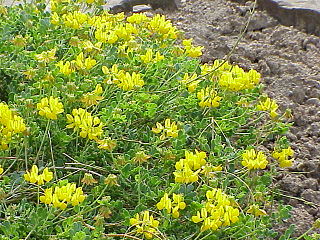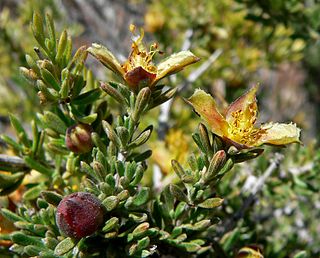
The willow flycatcher is a small insect-eating, neotropical migrant bird of the tyrant flycatcher family. There are four subspecies of the willow flycatcher currently recognized, all of which breed in North America. Empidonax flycatchers are almost impossible to tell apart in the field so biologists use their songs to distinguish between them. The binomial commemorates the Scottish zoologist Thomas Stewart Traill.

The genus Tamarix is composed of about 50–60 species of flowering plants in the family Tamaricaceae, native to drier areas of Eurasia and Africa. The generic name originated in Latin and may refer to the Tamaris River in Hispania Tarraconensis (Spain).

The genus Coronilla contains 8 species of flowering plants native to Europe and North Africa. It cointained about 20 species before being split into Securigera.

Aloidendron ramosissimum, formerly Aloe ramosissima, is a species of flowering plant in the family Asphodelaceae. It is endemic to the Richtersveld at the border between South Africa and Namibia, where it grows on desert slopes and in ravines. Its common name is maiden's quiver tree.

Helicia is a genus of 110 species of trees and shrubs, constituting part of the plant family Proteaceae. They grow naturally in rainforests throughout tropical South and Southeast Asia, including India, Sri Lanka, Indochina, Peninsular Malaysia to New Guinea and as far south as New South Wales.

Stromanthe is a genus of flowering plants in the family Marantaceae, native to the tropical portions of the Americas from Mexico to Trinidad to northern Argentina.
Tournefortia ramosissima is a species of plant in the family Boraginaceae. It is endemic to Ecuador. Its natural habitat is subtropical or tropical moist montane forests. It is threatened by habitat loss.

Coleogyne ramosissima or blackbrush, is a low lying, dark grayish-green, aromatic, spiny, perennial, soft wooded shrub, native to the deserts of the southwestern United States. It is called blackbrush because the gray branches darken when wet by rains. It is in the rose family (Rosaceae), and is the only species in the monotypic genus Coleogyne.
Utricularia geoffrayi is a small, probably perennial, terrestrial carnivorous plant that belongs to the genus Utricularia. U. geoffrayi is native to Indochina and can be found in Cambodia, Thailand, and Vietnam. It was originally published and described by François Pellegrin in 1920. It grows as a terrestrial plant among short grasses in or around rice fields at altitudes from sea level to 1,300 m (4,265 ft). It has been collected in flower between September and December.
HD 45652 b is a gas giant extrasolar planet orbiting at only 0.23 AU from the star HD 45652, with an orbital period of 44 days. It has mass at least half that of Jupiter. As it was detected using the radial velocity method, its true mass is dependent on the inclination of its orbit; if it is low, then the true mass will be larger. Also, its radius is not known. This planet was discovered by measurements taken by the ELODIE spectrograph from 2005 and 2006, and later confirmed by CORALIE and SOPHIE between 2006 and 2007. The discovery was announced in May 2008.

Euryomyrtus ramosissima, the rosy baeckea, is a shrub in the myrtle family (Myrtaceae). The species is endemic to Australia. It is spreading in habit and grows to 60 cm in height. Its leaves are dark green, long and narrow ranging from 3 to 13 mm in length and 1 to 3 mm in width. White, pink or mauve flowers with circular petals are produced between June and February in its native range.
Ctenanthe oppenheimiana, the giant bamburanta or never never plant, is a species of flowering plant of family Marantaceae and is a native of Brazil. It is an evergreen perennial. This plant can grow to more than 1 m (3.3 ft) tall and broad, with long narrow leaves up to 40 cm (16 in) in length. The leaves are adorned on the secondary veins with dark green bands, which meet and merge in the margins. In between are cream coloured bands. The undersides of the leaves have a red-ish colour. The cultivar ‘Tricolor’ is a common ornamental variety, which as a houseplant in the UK has gained the Royal Horticultural Society’s Award of Garden Merit.. This cultivar is visually very similar to Stromanthe Sanguinea 'Triostar', and the two are often confused. The difference between the two lies in the lack of regular banding on the leaves of the Sromanthe, and the generally more rounded shape of the leaves in Ctenanthe.

Tamarix ramosissima, commonly known as saltcedarsalt cedar, or tamarisk, is a deciduous arching shrub with reddish stems, feathery, pale green foliage, and characteristic small pink flowers.

Cylindropuntia ramosissima is a species of cactus known by the common names diamond cholla and branched pencil cholla.

Psathyrotes ramosissima is a species of flowering plant in the aster family known by the common name velvet turtleback, or turtleback. It is native to the southwestern United States where it grows in desert scrub habitat. It is a low, neatly mounded plant producing spreading stems which are hairless to densely woolly in texture. Leaves are borne on long petioles. The leaf blade is variable in shape, generally roughly rounded, and up to 2 centimeters long. It has a wavy, bluntly toothed edge and a bumpy, velvety surface coated in woolly fibers and shiny hairs. It is brownish to gray-green to very pale green in color. The knobby inflorescence is lined with woolly gray-green phyllaries with dull points that curve outward. It contains several hairy yellow disc florets. The fruit is an achene tipped with a large pappus of over 100 long, fine bristles.

The World's 25 Most Endangered Primates is a list of highly endangered primate species selected and published by the International Union for Conservation of Nature (IUCN) Species Survival Commission (SSC) Primate Specialist Group (PSG), the International Primatological Society (IPS), Global Wildlife Conservation (GWC), and Bristol Zoological Society (BZS). The IUCN/SSC PSG worked with Conservation International (CI) to start the list in 2000, but in 2002, during the 19th Congress of the International Primatological Society, primatologists reviewed and debated the list, resulting in the 2002–2004 revision and the endorsement of the IPS. The publication was a joint project between the three conservation organizations until the 2012–2014 list when BZS was added as a publisher. The 2018–2020 list was the first time Conservation International was not among the publishers, replaced instead by GWC. The list has been revised every two years following the biannual Congress of the IPS. Starting with the 2004–2006 report, the title changed to "Primates in Peril: The World's 25 Most Endangered Primates". That same year, the list began to provide information about each species, including their conservation status and the threats they face in the wild. The species text is written in collaboration with experts from the field, with 60 people contributing to the 2006–2008 report and 85 people contributing to the 2008–2010 report. The 2004–2006 and 2006–2008 reports were published in the IUCN/SSC PSG journal Primate Conservation,, since then they have been published as independent publications.

Grevillea ramosissima, commonly known as fan grevillea, is a shrub species of the family Proteaceae. It is native to south-eastern Australia.
Niebla ramosissima is a rare fruticose lichen that grows on soil on San Nicolas Island in the Channel Islands of California. The epithet, ramosissima, is in reference to the very much branched thallus.

Conyza ramosissima is a species of North American plants in the daisy family. It is widespread and common across the central part of the United States, its range extending from New Mexico east to Alabama and north as far as Pennsylvania, Ontario, and North Dakota.

Stromanthe sanguinea is a plant species in the arrowroot family Marantaceae, native to the Brazilian rainforest.















